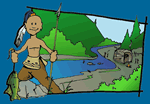


Geography and Landforms:
In the far north, Idaho is bordered by Canada. In the south, the state borders Nevada and Utah. Idaho is bordered by Montana and Wyoming on the east and by Washington and Oregon on the west.
|
 History:
The first Europeans to enter the area we now know as Idaho were probably members of the expedition led by Meriwether Lewis and William Clark in 1805. At this time, present-day Idaho was part of a larger area known as Oregon Country. Lewis and Clark thought the land in Idaho was too dry for farming, but they found fur-bearing animals that would be of interest to traders. David Thompson, a Canadian acting on behalf of the North West Company, established the first trading post in Idaho in 1809, and other fur traders were not far behind. In 1810, Andrew Henry of St. Louis, acting for the Missouri Fur Company, established the first American post in the state near the present-day town of Rexburg. Further exploration brought more settlers to the area. John Jacob Astor, one of the richest men in the United States, was interested in the lucrative fur trade, and he sent an expedition out to explore the Columbia River region and the Snake River. His fur trading post, Astoria, was established in 1811.
|
 Economy:
Until recently, agriculture was the most important industry in Idaho; recently it has been surpassed by manufacturing. The state is probably best known for its potatoes, and Idaho is the nation's leading producer of spuds. However, Idaho also produces hay, wheat, peas, beans, and sugar beets, and supports cattle and dairy herds.
|
 First Inhabitants:
Prior to the arrival of European and Mexican explorers, scientists estimate that around 8,000 Native Americans lived in the area we now call Idaho. These people can be divided into two distinct cultural groups: the Plateau and the Great Basin.
|
Books Related To IdahoBaseball Saved Us - Ken Mochizuki Charlie's Raven - Jean Craighead George Colder than Ice - David Patneaude Deadline - Chris Crutcher The Fences between Us - Kirby Larson The Girls of No Return - Erin Saldin The Last Good Place of Lily Odilon - Sara Beitia Lost It - Kristen Tracy Mailing May - Michael Tunnell My Darlin' Clementine - Kristiana Gregory P is for Potato: An Idaho Alphabet - Stan Steiner The Reinvention of Bessica Lefter - Kristen Tracy |
Famous Citizens:
|
| Capital: | Boise |
| Entered Union: | July 3, 1890 |
| Population: | 1,634,464 |
| Area | 83,570 |
| Bird | Mountain Bluebird |
| Flower | Syringa- Mock Orange |
| Nickname: | Gem State, Gem of the Mountains |
| Governor | C. L. Butch Otter |
Places to Visit in Idaho: (Click the links to learn more.)
|



